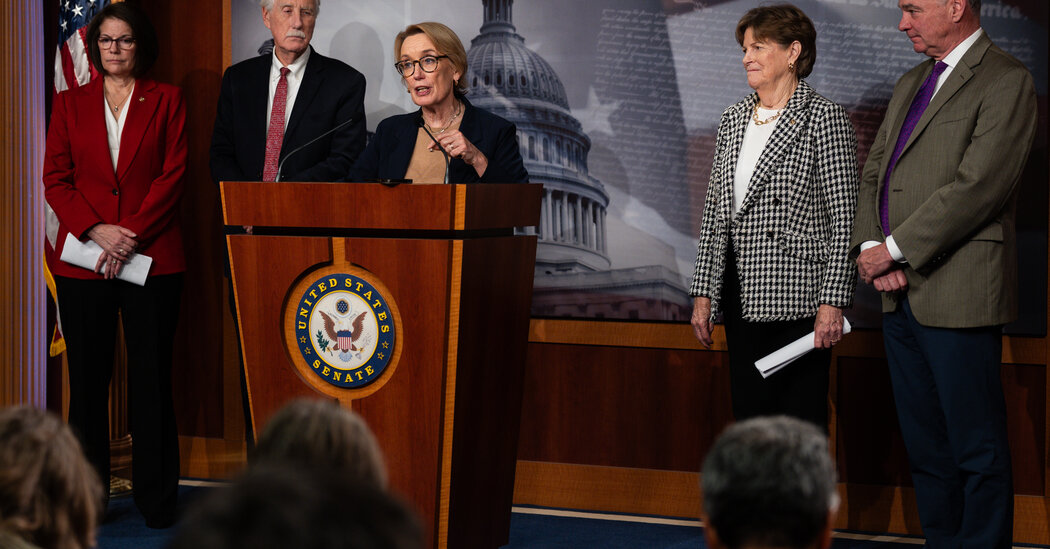Copyright The New York Times

Late last night, the Senate moved toward ending the longest government shutdown in U.S. history. A group of eight Democrats broke with their party to vote with Republicans, 60-40, to start the process of clearing the gridlock that has shuttered the government for more than a month, leaving hundreds of thousands of federal workers furloughed, millions at risk of losing food assistance and millions more stuck at airports. The spending agreement will still need to be debated and passed by the Senate, approved by the House and signed into law by President Trump. Here’s what we know right now: The spending agreement would fund the government through January and give federal workers back pay. It would not automatically extend health care tax credits that are set to expire at the end of the year, greatly increasing premiums for millions of Americans. Democrats spent weeks arguing that those subsidies were a crucial piece of any agreement. The deal allows the Senate to vote on them later. If they pass, they still may not survive a vote in the House. It would reverse layoffs of federal workers made during the shutdown. Senate Democrats who joined Republicans said the shutdown had become unsustainable. “A lot of people are being hurt,” said Senator Angus King, a Maine independent who caucuses with Democrats and voted to reopen the government. They pointed to the growing chaos at airports and suspended food stamp benefits for low-income families. (The administration has threatened to punish states that try to send food stamps anyway.) But many in the party were livid at the eight senators who backed down, primarily because the deal does not protect health care subsidies. Representative Hakeem Jeffries of New York, the minority leader, said House Democrats could not back the deal for that reason. “Donald Trump and the Republican Party own the toxic mess they have created in our country, and the American people know it,” he said in a statement. Next, both chambers will take up the spending bill. That should happen in the coming days. Until lawmakers enact it and the president signs it, though, the government remains closed. My colleague Michael Gold outlined six takeaways from the deal, worth considering. And you can follow our live coverage, too. We’ll have more news below. But first I’d like to tell you about a fascinating investigation by my colleagues David Fahrenthold and Claire Brown. It’s about the fall of the Sierra Club. An implosion They had one job. Taking on other ones was ruinous. That’s the state of the Sierra Club, which calls itself the “largest and most influential grass-roots environmental organization in the country.” David and Claire found that the group is now in the midst of an implosion — weakened by internal chaos, stalled fund-raising efforts and declining membership. It is not in a good place to fight the Trump administration’s attacks on environmental protections, as it was during Trump’s first term, nor to organize effectively to protect the nation’s public lands and water. “Sierra Club is in a downward spiral,” a group of managers wrote in June, according to a letter David and Claire saw. That spiral is one the organization entered entirely on its own, they report. Flush with volunteer support and cash accrued during the first Trump presidency, the group’s leaders widened the aperture of their environmental campaigns, taking on a broad array of progressive causes. As happened at scores of progressive organizations across the nation during the same period, they embraced the fight for racial justice and for labor, gay and immigrant rights. The club rewarded its union members with higher wages. It issued an “equity language guide,” warning employees not to use words like “vibrant” or “hardworking,” because they smacked of racism. It called to defund the police, and to provide reparations for slavery. It turned on its founder, John Muir, for using racist stereotypes when he wrote about Black people and Native Americans in the 1860s. The loss of focus, David and Claire discovered, led to a loss of strength. The group’s finances cratered. Its coalition of supporters splintered. Many left. The pivot to generalized social justice causes obscured the fact that the Sierra Club had been founded with only one: the protection of the environment. Intention vs. reality The club doesn’t see it that way. Leaders told the reporters that its woes came about because of external factors — a decline in alarm about the environment after the election of Joe Biden as president in 2020, inflation in the post-pandemic economy, a dip in the stock market in 2022. Trump’s return did little to help, though. “We didn’t have a direct ‘Trump bump’ in the same way we did for the first Trump administration,” the executive director told the reporters. In fact, the opposite happened. The club’s supporters, including financial backers, fell 60 percent from a high in 2019, according to internal tracking documents reviewed by David and Claire. There were fractures within the organization as well. The club’s embrace of progressive values “curdled into a culture of allegations and investigations,” our reporters wrote. Some volunteers said they were investigated without being told why. One told David and Claire that she was scolded for saying the club should lobby Colorado’s Legislature on behalf of wolves. She said she was asked, “What do wolves have to do with equity, justice and inclusion?” (In journalism, when someone makes an accusation like that, you usually give the other side a chance to respond. David and Claire did so. Sierra Club officials told them, “No one was investigated or accused of values misalignment on the basis of wolf conservation efforts.”) There are no signs that Sierra Club will be reverting to its singular cause of environmentalism any time soon. David and Claire spoke to the club’s board president, Patrick Murphy, who has helped run the place since 2020. They asked him if he could name a decision he regretted. “I have a hard time pinpointing how I believe we should have made different choices,” he responded. “And I’m happy with where we are today.” You can read the story here. Now, let’s get you caught up. THE LATEST NEWS Government Shutdown The bipartisan spending deal contains some provisions that run counter to Trump’s wishes. It protects the Government Accountability Office, which has found fault with his budget-cutting efforts. It also funds a food-aid program that Trump has moved to eliminate. If the government stays closed this week, more flights could be canceled at the nation’s busiest airports. (Thousands have already been canceled. See them on a map.) In Alaska and Hawaii, where groceries are the most expensive in the country, residents are facing sharp anxieties over the availability of food stamps. More on Politics The conversation between the two of them is insightful, and important. We need critics to help us form our tastes. That includes their reaction to mediocrity in art — especially when some of us think it’s decent art. To keep our standards high, we need arbiters who listen harder than we do, who listen all day long. That’s K, that’s Wesley. Listen to them. More on culture Jesse Green wrote about the history of Black Broadway, which started far earlier than you might think. It’s just fantastic. The New York Times Book Review occasionally looks back at a book published years ago. Today, it takes up Jennifer Dawson’s debut novel, “The Ha-Ha,” from 1961. (Sylvia Plath was reading it the weekend before she died.) Dawson should be celebrated, Naomi Huffman argues, “for the startling clarity of her sentences, the compassion with which she makes her wallflower characters fully bloom.” “The Queen of Versailles,” a gilded new musical about a wealthy couple trying to build the largest private home in America, opened on Broadway last night. We’re back from the theater with a review — a good one. THE MORNING RECOMMENDS … Get a little more serious about measuring ingredients with these spoons and cups, recommended by the kitchen sharks at Wirecutter. Watch the 56th season premiere of “Sesame Street,” on Netflix and PBS. Shave better, with guidance from the stylish professionals at T Magazine. (It’s a process!)



